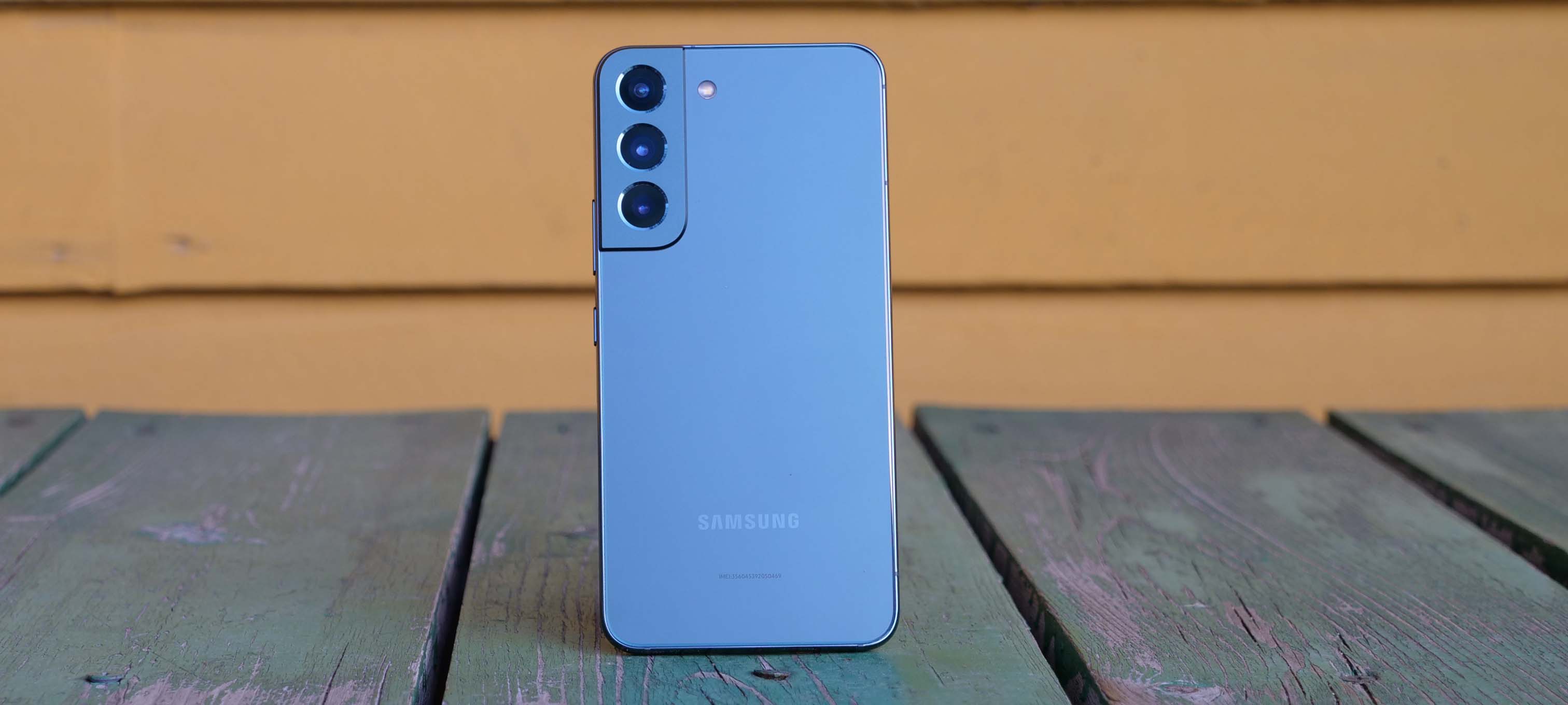Laptop Mag Verdict
The Galaxy S22 may look like its predecessor, but a number of changes inside make it a much more compelling option for most users.
Pros
- +
Upgraded triple camera array
- +
Excellent software support
- +
Compact and durable design
- +
Bright 120Hz display
- +
Powerful Snapdragon 8 Gen 1 processor
Cons
- -
Disappointing battery life
Why you can trust Laptop Mag
Price: $799
OS: One UI 4.1 (Android 12)
Display: 6.1-inch (2,340 x 1,080 pixels) Dynamic AMOLED 2X with adaptive 120Hz
CPU: Qualcomm Snapdragon 8 Gen 1
RAM: 8GB
Rear cameras: 50MP wide (ƒ/1.8); 12MP ultra-wide (f/2.2); 10MP 3x telephoto (f/2.4)
Front camera: 10MP (f/2.2)
Storage: 128 or 256GB
Battery: 11:00 (60Hz)
Size: 5.75 x 2.8 x 0.3 inches
Weight: 5.9 ounces
The Galaxy S22 is in many ways the high-end phone that plenty of Android fans asked for, delivering absolute flagship specs in a light and compact frame.
This includes the new Snapdragon 8 Gen 1 processor, a triple camera array with telephoto, a bright and vivid 120Hz adaptive display and now the best software support of any Android phone on the market with four years of major OS updates and security updates. All of these positives are what make the weak battery life when using its more powerful features all the more painful.
I struggled to come up with anything else bad to say about the Galaxy S22. But in almost every regard, this is one of the best smartphones available today. And for the right person, this could still be perfect, read on to see if that’s you.
Samsung Galaxy S22 price and configurations
The Galaxy S22 starts at $799, which includes 8GB of RAM and 128GB of internal storage. For just $50 more, you double your storage to 256GB.
If you are an avid mobile photographer or videographer or you are going to keep the phone for more than a couple of years, the upgrade is worth the cost as storage limitations are irritating and can slow your phone down over time. If you pre-order the Galaxy S22 by February 24, you can get the upgrade to 256GB for free, so you won’t have to worry about that choice.
The Galaxy S22s pricing is competitive with most other flagships and Samsung’s new four years of major Android and security updates puts it back at the top of the Android software support charts. It stacks up well against Apple’s standard iPhone 13, which for the same $799 lacks a telephoto lens or a 120Hz display. The Pixel 6 and Pixel 6 Pro at $599 and $899 respectively have the price and telephoto lens advantage, but performance and support go to Samsung.

Samsung Galaxy S22 design
The Galaxy S21 introduced the bold new Contour Cut Camera housing to the Galaxy S line, delivering a unique profile to the former slab and the Galaxy S22 pretty much just sticks with that. There are some changes, the camera array is slightly thinner and it is now color-matched to the back of the phone rather than the contrasting colorways available last year, but overall it’s the Galaxy S21 redux.
Sign up to receive The Snapshot, a free special dispatch from Laptop Mag, in your inbox.
Some are going to criticize this as boring, but frankly, I think it’s ridiculous to expect manufacturers to make drastic design changes on a yearly basis. I was a big fan of the new design last year and though it may not be as fresh, it remains an excellent design that stands out from the rest of the Android market (until the OnePlus 10 launches anyway). And while the aesthetic changes may be minimal, one complaint from the Samsung faithful didn’t go unheard as the company upgraded the back to Gorilla Glass Victus+ from the much-lamented polycarbonate “glasstic” found on the Galaxy S21. I wasn’t too bothered by it, but there’s no question the glass back has a more premium feel befitting an $800 phone.
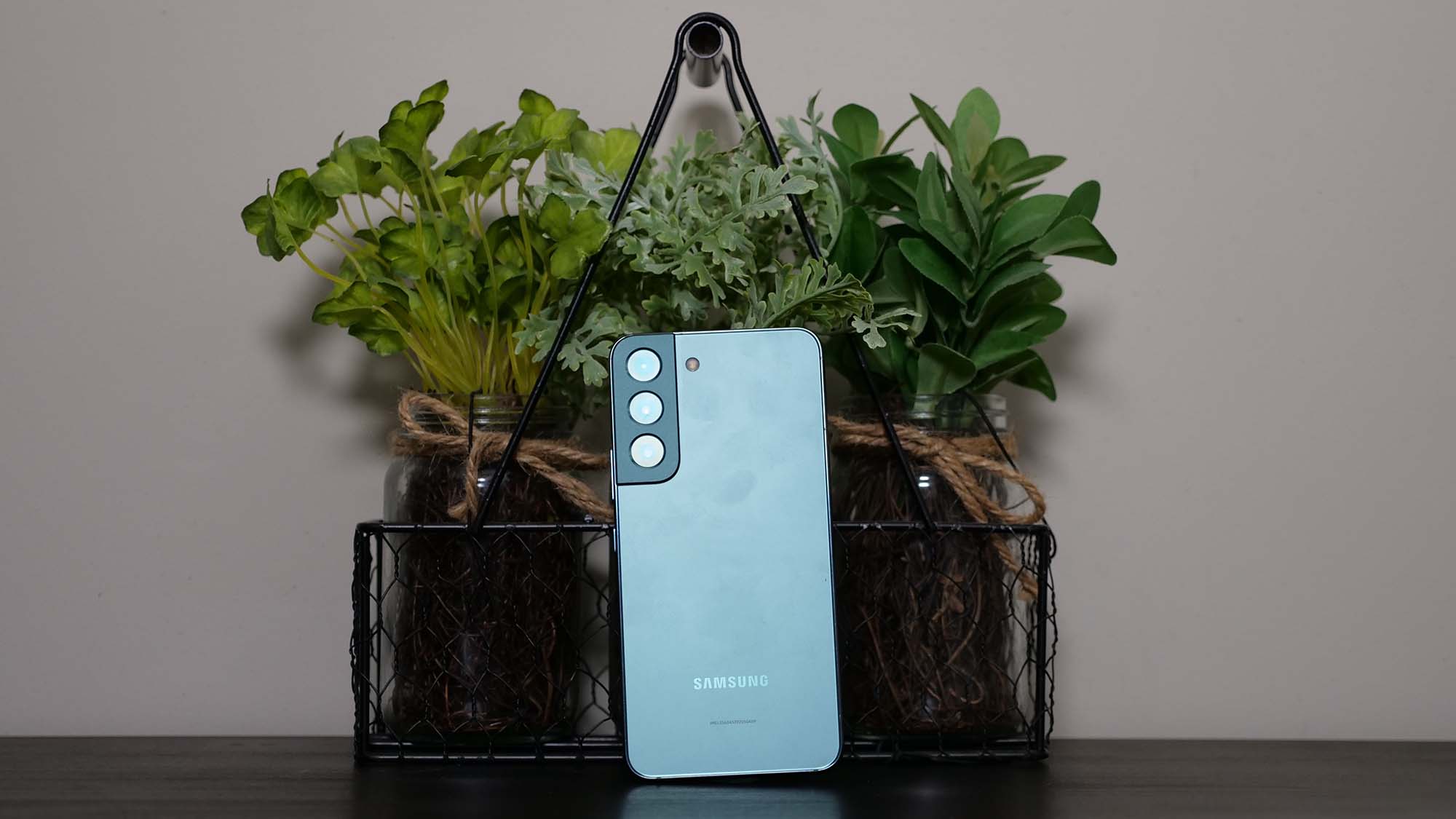
Despite the upgraded materials, the phone remains incredibly light at just 5.9 ounces and with the move to a 6.1-inch display, it's the most pocket-friendly phone I’ve reviewed at 5.75 x 2.8 x 0.3 inches. It’s slightly narrower, shorter and lighter than the iPhone 13 (5.8 x 2.8 x 0.3 inches, 6 ounces) and positively lilliputian compared to the Pixel 6 Pro (6.45 x 3 x 0.35 inches, 7.4 ounces) and OnePlus 9 (6.3 x 2.9 x 0.34 inches, 6.8 ounces).
I love the green colorway on my review model, but anytime we can get away from black and silver as the sole options I’m pretty happy. I can appreciate that this probably has the broader appeal, but I do miss the bold contrasting Contour Cut Camera housing colors from last year. There’s no question that this makes it look slimmer and sleeker though, which was likely part of the intention of that design anyway. The rounded corners and edges make the small device more pleasant to hold than the angular iPhone 13, for example. The flat display may not look as premium as the waterfall display on the S22 Ultra, but from a usability standpoint, I still prefer it.
Galaxy S22 offers IP68 dust and water resistance certification. Combined with the Gorilla Glass Victus+ covering the display and back of the phone along with the “Armor Aluminum” frame and the Galaxy S22 should prove one of the more durable phones around.
No changes to the ports and buttons this time around with just the power/multifunction button and volume rocker on the right and a USB-C port and SIM card slot at the bottom.

Samsung Galaxy S22 display
While the Galaxy S22 display drops to 6.1-inches (from 6.2 on the Galaxy S21), the FHD+ (2340 x 1080 pixels) Dynamic AMOLED 2X display with its adaptive 120Hz refresh rate remains amazing in every regard. Samsung’s mobile displays are as untouchable as Apple’s mobile chips, the only difference is that Samsung sells its displays to other manufacturers.
However, as you’ll see in our testing, it does seem to save the best for itself, or Samsung is just willing to splurge on its displays more than others.
I took a vacation into the visual feast that is Life in Color with David Attenborough and watched some of the “Seeing in Color” episode to see how the Galaxy S22 display performed. With the display tuned to its Vibrant mode, the tiny as they are deadly poison dart frogs absolutely jumped off the screen (not literally thankfully) with deep reds, blues and greens that also sharply capture the reflections off their glistening backs.
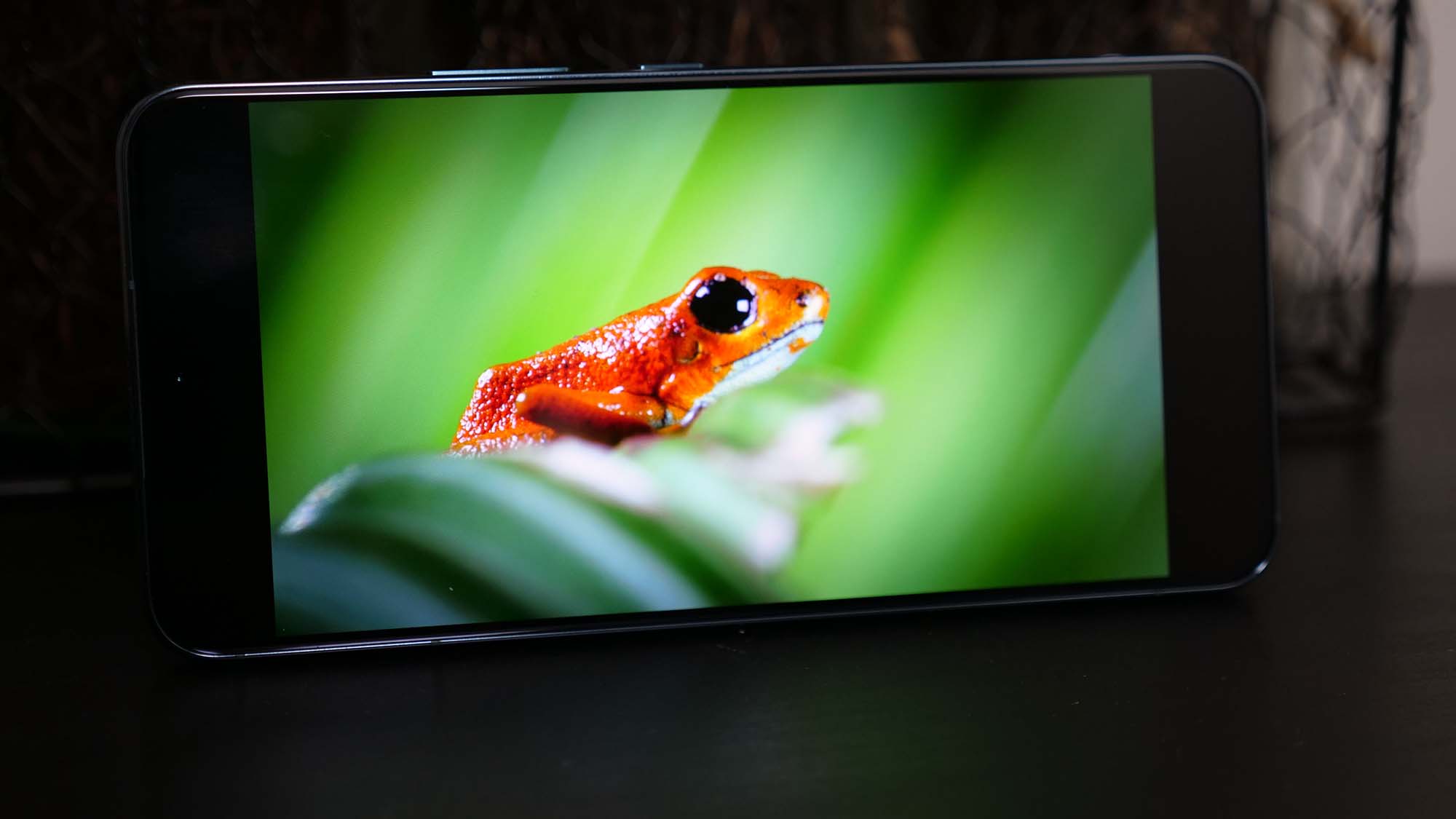
Our lab tests delivered nuanced and much more scientific support to my findings with the Galaxy S22 reproducing 79.4% of the DCI-P3 color gamut in its Natural color setting. The iPhone 13 (78.1%) wasn’t far behind, while the Pixel 6 and OnePlus 9 rounded things out at 73.8% each. However, Android phones let you crank that saturation up to 11 in Vivid mode and here the Galaxy S22 tops out at an astounding 151.1%, which the OnePlus 9 (141.3%) still can’t quite match and the iPhone 13 is left asking Apple engineers why it can’t have a vibrant mode of its own.
Our Delta-E color accuracy test results (lower is better) were quite good for the Galaxy S22 at 0.24 in its Natural setting. The iPhone 13 again finishes slightly behind at 0.26 with the OnePlus 9 (0.27) chasing it and the Pixel 6 Pro (0.3) coming in last.
The Galaxy S22 in its maxed-out settings absolutely crushed our brightness test with a peak of 1,191 nits. That’s almost comically beyond what the iPhone 13 (795 nits), OnePlus 9 (696 nits) and Pixel 6 Pro (842) can offer. It’s worth noting that on its probably more reasonable brightness settings it tops out at 684 nits, which is still bright enough to see in full daylight, just like the rest of the phones in the group.
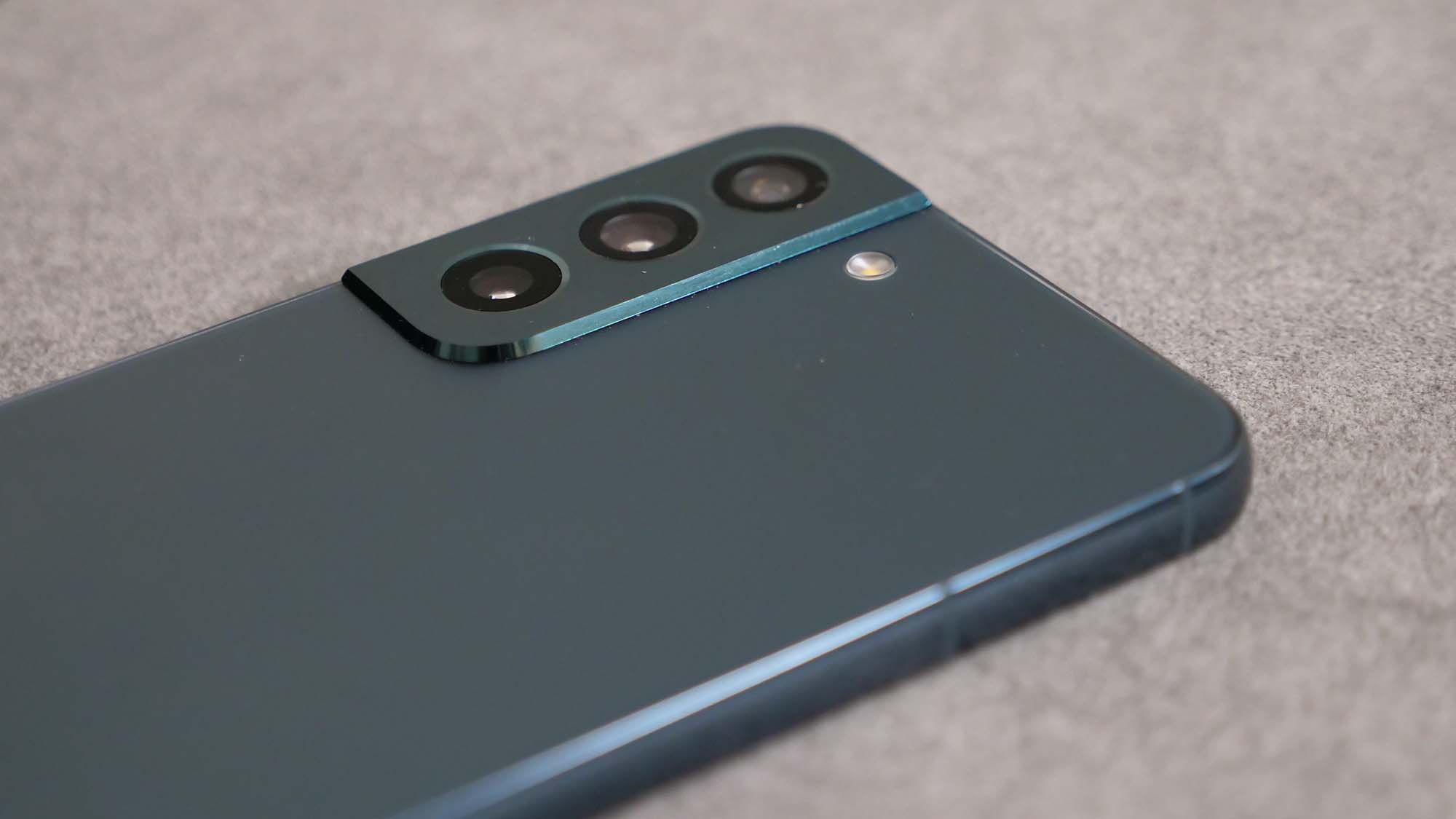
Samsung Galaxy S22 cameras
The Galaxy S22 camera array may look identical to the Galaxy S21, but under the hood, things have changed pretty dramatically. The biggest upgrade is to the primary wide-angle camera, now boasting an impressive 50MP sensor at f/1.8 which uses “tetra binning” to create much brighter and more detailed 12MP photos. This is similar to what we’ve seen from Samsung’s own 108MP sensor on the S21 Ultra and now S22 Ultra, or Google’s Pixel 6 and Pixel 6 Pro.
Conversely, the telephoto on the Galaxy S22 drops to a 10MP at f/2.4 (down from a 64MP at f/2.0), but it now features a 3x optical zoom as opposed to the 3x hybrid zoom. On the specs sheet this feels like a downgrade, but the optical zoom is so much more important than those added megapixels and I think the samples bear this out. The ultra-wide (12MP f/2.2) and front-facing (10MP f/2.2) cameras remain identical.
While there’s room to quibble about the telephoto changes, the primary camera is a substantial upgrade when it comes to low-light performance thanks to the 24% larger sensor size. Coupled with Samsung’s advancements with what it is now branding as its Nightography mode, you can get some excellent results in pretty terrible lighting conditions. The photos below show both aspects of this off with the first shot of the fountain captured from the wide-angle and the second with the ultra-wide. You would assume there’s a reasonably strong light behind me, but the only ambient light is coming from behind the fountain, making this all the more impressive. It does push the colors too warm, but that can be fixed with a quick edit and it’s drawing out excellent detail.

Samsung Galaxy S22 wide-angle Nightography

Samsung Galaxy S22 ultra-wide Nightography
In daylight, the primary lens produces outstanding color that I feel is finally toned down a bit from Samsung’s traditional saturation fest. The samples below show this off with the local festive holiday display featuring red berries that Samsung would have turned into an eye-searing red in years past. The somewhat tragic dirty half-melted snow in the foreground aside, the converted train station photo gives another glimpse at this with the dull mustard yellow and cranberry paint job contrasting well with the blue of the sky, but none of them push into the hyperreal color palette that I’ve grown accustomed to from Samsung.


The ultra-wide feels similarly toned down and matches up well with the primary lens in color. This slider will let you see how close they get with a shot of a nearby mural. One drawback I noticed with the ultra-wide is fairly aggressive distortion at the edges, which you’ll see in this shot as well. It’s hardly limited to Samsung, but it’s something to be aware of when you are framing an ultra-wide shot, particularly if it’s of people that likely won’t appreciate being stretched and distorted in the group photo.
I wasn’t sure what to expect with the telephoto with the perceived downgrade, but as I mentioned at the outset the bump up to a 3x optical zoom is worth more than those extra megapixels. Here’s a sampling of shots showing the 3x optical and 30x digital zoom. It’s no 100x Space Zoom, but it does a solid job and will absolutely get you shots that would be lost on a phone without a telephoto.





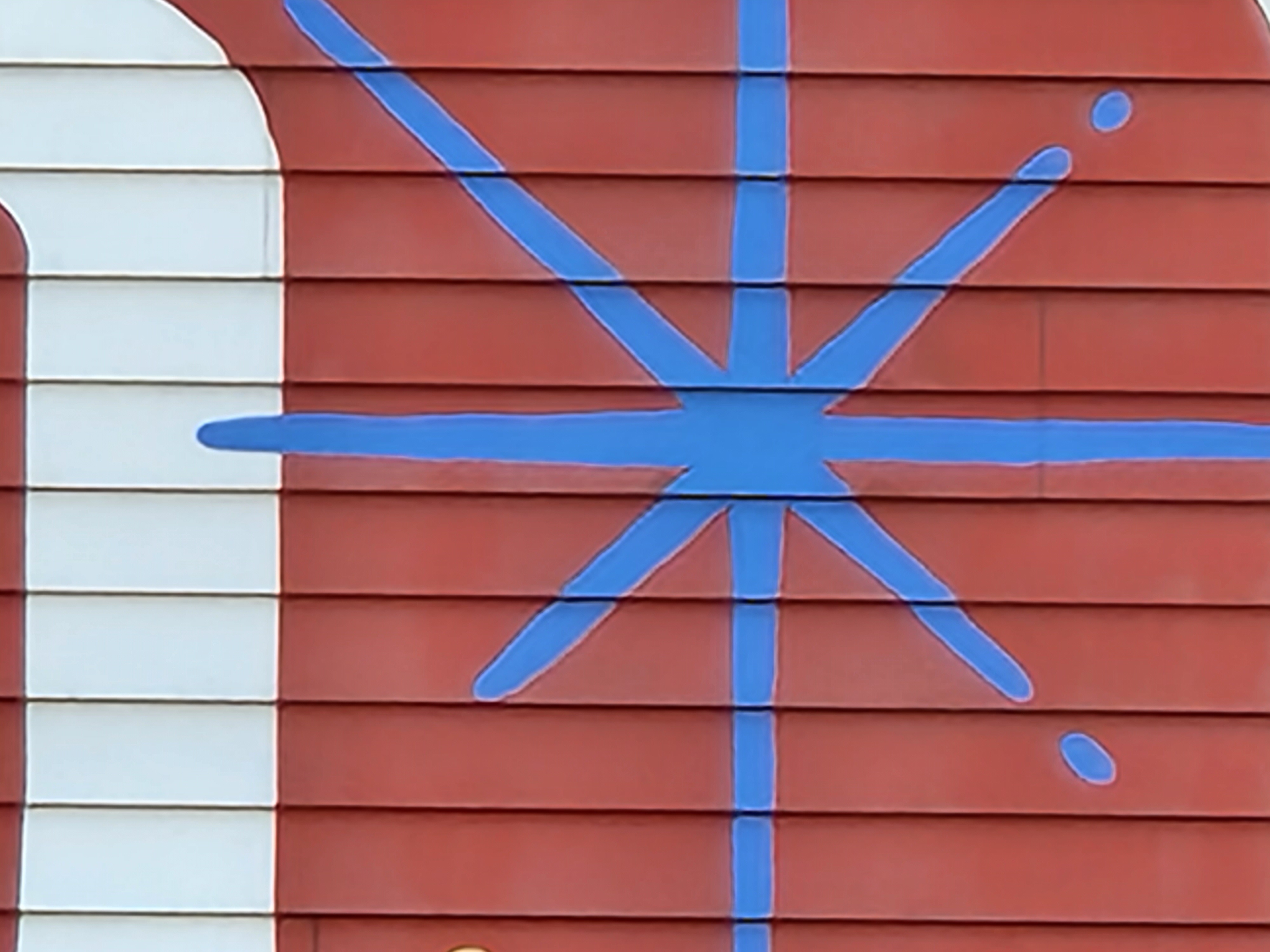
I also spent some time with the portrait mode on the Galaxy S22, my pug was kind enough to chip in his modeling services. You can switch between a 1x and 3x zoom for portraits and I was impressed with the progress that Samsung appears to have made in both. There’s certainly still a bit too much of a fall-off in the bokeh at places, but it’s not the blatant software applied blurring that it once was.

Samsung Galaxy S21 FE front-facing camera - default resolution

Samsung Galaxy S21 FE - front-facing camera - full resolution
Portrait mode on the front-facing camera was a different story. Now I’ll grant that my hair can be a little bit of a mess, but it went at the edges of my hair with a butcher’s knife. Unless you have tight coiffed hair, I’d recommend steering clear of the front-facing portrait mode and without that added bit of software in the way, it produces sharp images and accurate color.
Samsung Galaxy S22 performance and graphics
The Galaxy S22 features the same Snapdragon 8 Gen 1 processor as the rest of the Galaxy S22 series and pairs that with 8GB of RAM just like the S22+ and the base model S22 Ultra. The Galaxy S22 is the sports coupe of the S22 lineup, packing the horsepower of its much larger siblings into its diminutive frame. Hmm…a tremendous amount of power and not a lot of space inside, I wonder if that might have ramifications for battery life, we’ll check in on that in the next section.
The Galaxy S22 ran laps around my typical array of smartphone tasks, loading up a couple of dozen Google Chrome tabs, running a Netflix video in the background, and then swapping between several apps including Twitter, YouTube Music, and Gmail. This is hardly a surprise, the last couple of generations have proven that hardware has outpaced the demands of smartphone apps.
We’re a couple of years into 120Hz as the standard refresh rate for flagship Android phones, so there are certainly some users upgrading from an older 120Hz phone, but for those just trying it is transformative, particularly on Android which hasn’t historically been known for its smooth animations and transitions. OS level support is excellent, but increasingly apps and games are adopting 120Hz support. I fired up PUBG Mobile to put the game to the test and it was more than up to the challenge. Even with the graphics and refresh rate maxed out the game held up well, leaving me with no one to blame except myself when I was picked off as I moved to join my teammate in the final zone.

The Geekbench 5 score for the Galaxy S22 is solid with a multicore result of 3,341. Naturally, that isn’t within screaming distance of the iPhone 13 (4,436), but even the Snapdragon 888-powered OnePlus 9 (3,618) beat it by a reasonable margin. Only the Pixel 6 Pro (2,760) with Google’s new Tensor chip failed to keep up.
Our Adobe Premiere Rush test has the phone convert a 4K video to 1080p, the Galaxy S22 finished in 48 seconds. The iPhone 13 Pro (26 seconds) crushed that, but it came in dead even with the graphics-focused Pixel 6 Pro and is a notable improvement over the OnePlus 9 (1:01) and the Galaxy S21 (1:03).
Graphics testing is where the Galaxy S22 finally gets to grab the gold medal. In the Wild Life Unlimited graphics test, the Galaxy S22 hit 60 frames per second, obliterating the 34fps achieved by the Pixel 6 and OnePlus 9 and even eclipsing the iPhone 13 (56 fps). This is the first time we’ve seen a phone outperform the iPhone 13 on this test.
While the CPU benchmarks may not be mind blowing, the real-world performance is more than equal to anything you’ll throw at it and the graphics improvement is nothing short of astonishing. However, as I not so subtly hinted at the outset, all of that power comes at a cost.
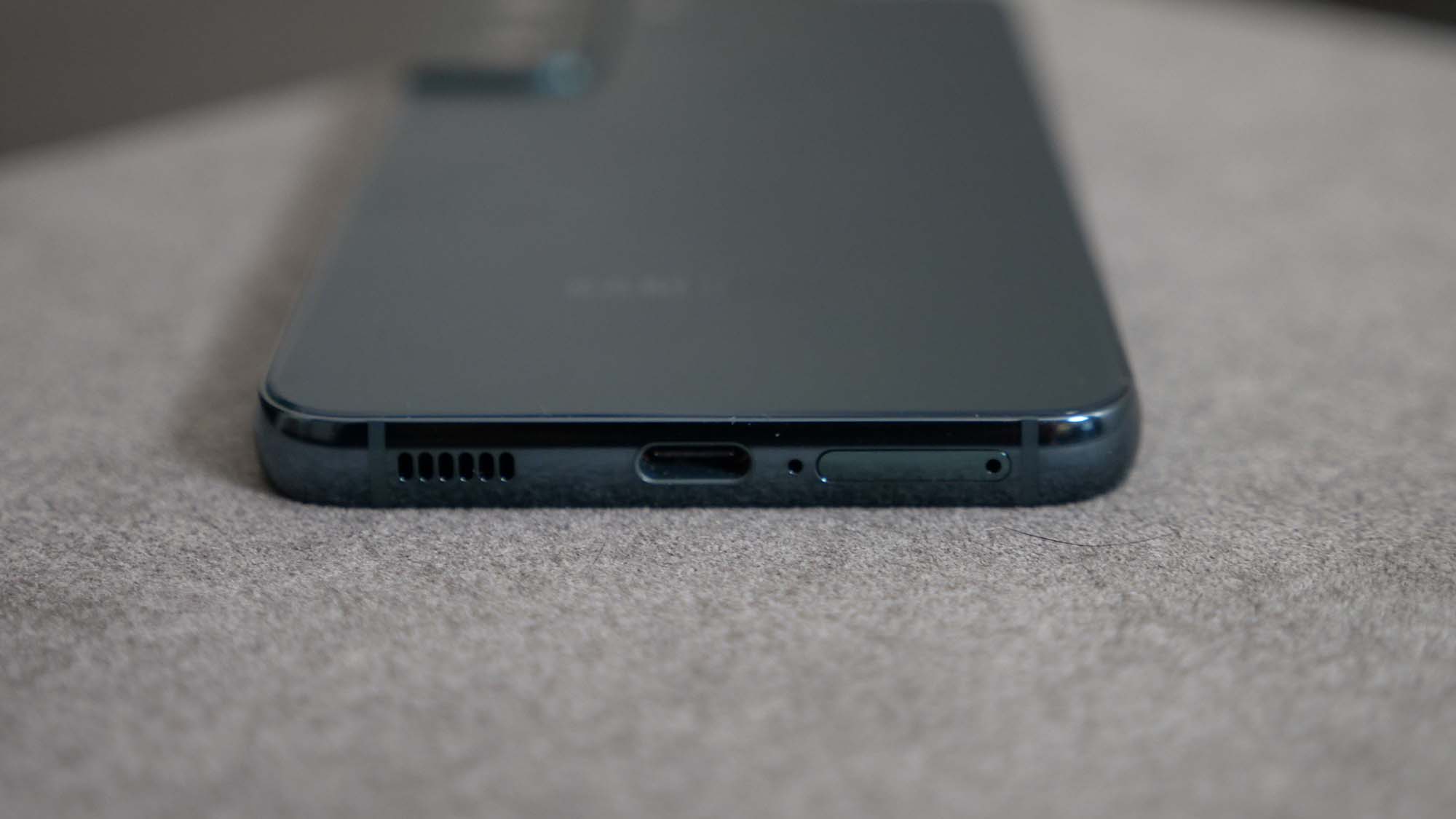
Samsung Galaxy S22 battery life and charging
Welcome to the Achilles heel of the Galaxy S22 for some users. I’m not certain what Samsung was thinking by dropping the battery size to 3,700mAh from the 4,000mAh of the Galaxy S21, but it didn’t quite work out. Depending on the tasks that you undertake and some of the settings choices you make it could be fine, but power users will need an external battery or mid-day recharge.
As a refresher, the Galaxy S21 didn’t have brilliant battery life, it made it 6 hours and 31 minutes in our testing with the display on its adaptive refresh rate mode and a more respectable 9 hours and 53 minutes if locked to a 60Hz refresh rate. The first is wildly short of acceptable and the latter forces you to sacrifice one of the phone's highlight features, so again I can’t fathom how Samsung could have thought, “yeah we’ve got some battery capacity to spare.”
Our Laptop Mag Battery test has the phone continuously surf the web over cellular with the display set to 150 nits of brightness, the Galaxy S22 on its 60Hz setting lasted 11 hours and 03 minutes. That manages to overtake the iPhone 13 (10:33) and OnePlus 9 (10:53), while the Pixel 6 Pro (7:47) failed utterly to compete in its static 60hz setting. We are in the process of completing our testing on its adaptive refresh rate mode and will update as soon as we have those numbers. It's a notable improvement, but as you'll see it won't hold up for all use cases.
During my reviews, I typically take the phone off the charger at 7:30 a.m. and return it to the charger at around 10:30 p.m. after roughly 2 hours of Netflix and/or YouTube streaming on Wi-Fi, web browsing, using social media, gaming for about 30 minutes and capturing photos and videos. With that basic mixed usage, I was typically coming in with under 10%, but enough to get by.
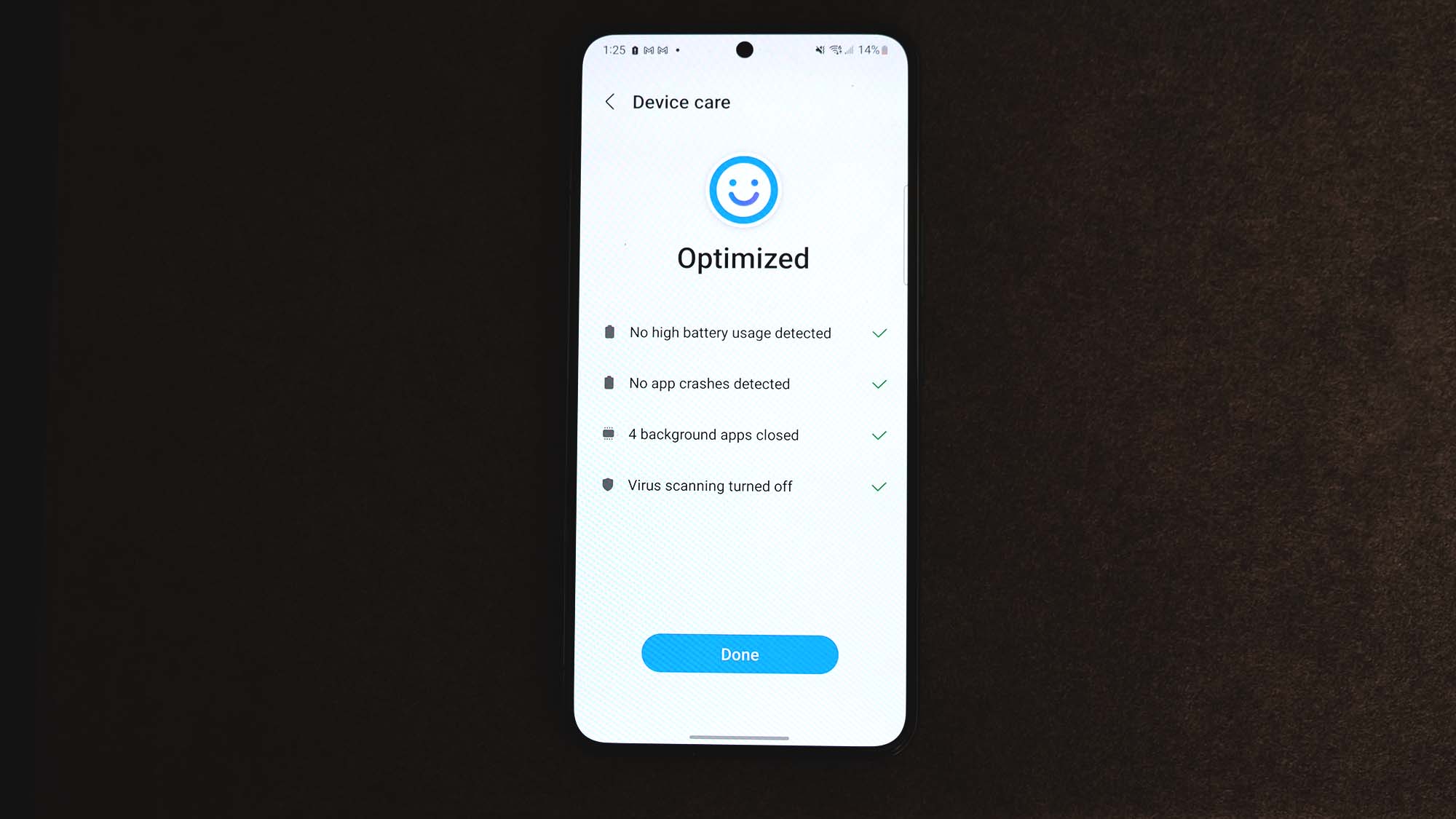
However, I had absolutely no trouble killing the phone if I pushed anything more battery intensive. Gaming in particular just slaughters the Galaxy S22 battery, playing PUBG on max settings you can basically watch the battery percentage tick down at roughly 1% per minute. Video or extensive photo usage isn’t as aggressive, but I can’t imagine it making a full day on a family vacation where you’re capturing photos and videos regularly. The Galaxy S22 will be near the bottom of Samsung’s chart on our phones with the best battery life. If you love the small form factor enough to overlook this, you should consider picking up an external battery pack for days when you really can’t afford to have your phone die on you.
Superfast charging may have made this OK, but no, the Galaxy S22 is unchanged from the Galaxy S21 with 25W wired fast charging, if you pick up the necessary adapter that is, and 15W wireless charging. This is still on a par with the iPhone 13, but with the S22+ and S22 Ultra making the leap to 45W, it’s disappointing as this phone could desperately use the ability to top up in a flash.
Samsung Galaxy S22 software
The Galaxy S22 runs Samsung’s One UI 4.1, a modified version of Android 12. I’ll get to some of the features of One UI in a moment. But the best news is that Samsung extended support for the Galaxy S22 series to four major Android updates and four years of security updates, putting it at the top of the podium among Android manufacturers –– your move Google. You’ll be on the latest and greatest software from Google through 2025.
One UI 4.1 adds a couple of notable features to One UI 4.0, but still ignores the new Material You design found on the Pixel and other devices hewing closer to the standard Android 12 look.Given how substantial a departure it is, it will probably be welcome news to some users. For those not already on One UI 4.0, it brought with it the considerable customization options available in Android 12 to change the look of virtually anything on your device. The more robust privacy features are present as well with granular controls over what data and features apps have access to, further bolstered by Samsung’s Knox hardware built into the phone.
One UI 4.1 now added a new Pro mode to use all three rear cameras simultaneously, similar to what the iPhone got last year. Night mode and the ultra-wide lens are now available to use in some apps like Instagram and Snapchat. Those extras are nice, but there’s no question that the biggest update to the Galaxy S22 is the news that it will have software support longer than any of its Android competitors.

Bottom line
The Galaxy S22 at $799 should be a killer option for those that aren’t sold on the iPhone 13 with all of the true flagship phones that Apple didn’t bring to its non-Pro models this year. However, the battery life is a crushing blow to many of the power users that will appreciate those extra features.
Using the 120hz display for gaming or recording 4K video will leave you with a dead hunk of glass and metal hours before you are ready to turn in for the night. The lack of the new 45W fast charging adds insult to injury as you could otherwise just spend 10 minutes to easily power it up for the rest of the day. Now if you aren’t bothered by sticking to 60Hz, aren’t gaming or spending hours on photos or video work or you simply take some time to charge up your phone a couple of times during the day then this isn’t a dealbreaker.
The rest of the package is so compelling that the disappointing battery life shouldn’t dissuade you from considering the Galaxy S22. However, it should make you take a moment to consider the Galaxy S22+, which packs a much more substantial 4,500mAh battery along with the larger 6.6-inch display. For those that want the small form factor, the Galaxy S22 is unquestionably the best pocketable flagship phone I’ve ever used, just keep a charger handy.
Sean Riley has been covering tech professionally for over a decade now. Most of that time was as a freelancer covering varied topics including phones, wearables, tablets, smart home devices, laptops, AR, VR, mobile payments, fintech, and more. Sean is the resident mobile expert at Laptop Mag, specializing in phones and wearables, you'll find plenty of news, reviews, how-to, and opinion pieces on these subjects from him here. But Laptop Mag has also proven a perfect fit for that broad range of interests with reviews and news on the latest laptops, VR games, and computer accessories along with coverage on everything from NFTs to cybersecurity and more.
